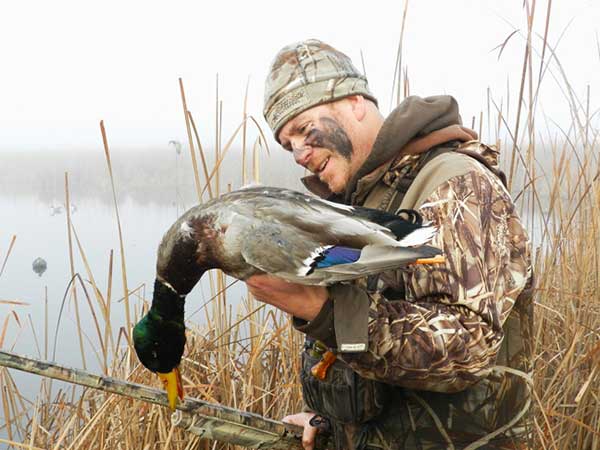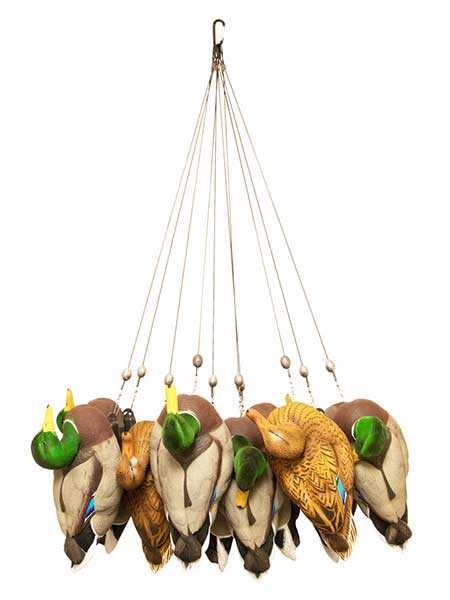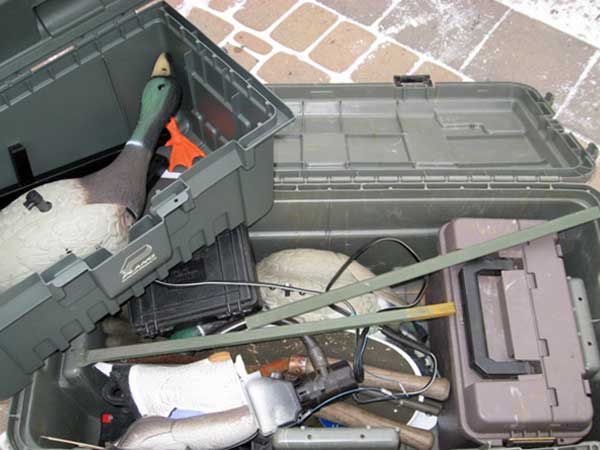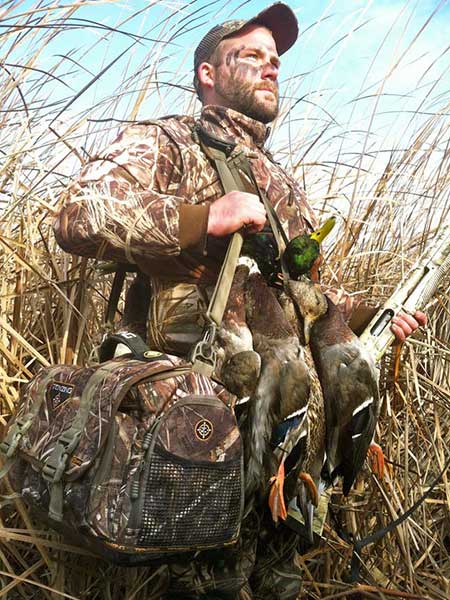By Josh Lantz, Traditions Media
 Joe Balog’s appreciation for organization has been garnered from thousands of trips on the water as a hunting and fishing guide. Waterfowlers are a dedicated bunch who finds wet, cold and windy weather ideal hunting conditions.
Joe Balog’s appreciation for organization has been garnered from thousands of trips on the water as a hunting and fishing guide. Waterfowlers are a dedicated bunch who finds wet, cold and windy weather ideal hunting conditions.
Such miserable elements prompt ducks and geese to move more regularly between roosting, feeding and loafing areas while also pushing fresh birds down along their fall migration routes. Sure, itís nasty outside, but youíd better be there if you want a shot at knocking them down.
Our sport is also gear-intensive, requiring long hours of preparation before we even set foot in the field or marsh. Once that abundant gear is readied, it needs to be transported to and from the field in some of the most challenging conditions imaginable.
Many waterfowlers make things harder than they need to be, inflicting unnecessary pain upon themselves and others in their hunting parties through a lack of organization.
Michigan waterfowl pro Joe Balog logs hundreds of hours each season on the storied St. Clair Flats, home to some of the largest concentrations of migrating waterfowl in the harsh and unforgiving Great Lakes region.
Organization is critical to Balogís waterfowl strategy. From decoys to dogs and the myriad of other gear he takes to the field, every piece of equipment has its proper place in Balog's waterfowl system.
"When you hunt daily, as my group often does, anything less than total organization makes life miserable," he says.
 Texas rigging your decoys is one of the best things a duck hunter can do to minimize headaches in the field.Decoys are among the most cumbersome and space-intensive hunting essentials imaginable. They are bulky, heavy and require anchors and lines that can quickly become a tangled nightmare when rigged and transported traditionally.
Texas rigging your decoys is one of the best things a duck hunter can do to minimize headaches in the field.Decoys are among the most cumbersome and space-intensive hunting essentials imaginable. They are bulky, heavy and require anchors and lines that can quickly become a tangled nightmare when rigged and transported traditionally.
While many hunters employ vast decoy spreads, especially during flight days, Balog rarely does.
"I hunt an area with large numbers of mallards and incredibly high hunting pressure," says Balog, who seeks out tiny, remote pockets to hunt, where smaller decoy spreads yield excellent results. In this case, smaller often means just 9-24 decoys. Less is more, and realism is key.
"I want my spread to look like small groups of ducks gathered in a remote sweet spot to escape pressure and loaf," says Balog, who uses mostly mallards, with a couple of other species like gadwall or widgeon mixed in. "Late in the season I use more black ducks."
Balog forgoes traditional decoy rigging and the accompanying potential for temper-flaring tangles in favor of a Texas-style rigging system made by Rig 'Em Right.
"Texas rigging their blocks is one of the best things marsh hunters can do to eliminate headaches in the field," says Balog, who keeps rigs of 6 to 12 decoys worry-free and ready inside 108-quart Plano Sportsman's Trunks.
 Durable, waterproof Sportsman’s Trunks, like these made by Plano, are steps ahead of the cheap ones you’ll need to replace each season, and serve double duty as movable shooting benches. Photo courtesy of Joe Balog."These surprisingly affordable and durable trunks are like gold in my boat," says Balog, who also uses them as movable shooting benches and dog platforms in addition to a place to stash other gear, like PFDs and dry clothing.
Durable, waterproof Sportsman’s Trunks, like these made by Plano, are steps ahead of the cheap ones you’ll need to replace each season, and serve double duty as movable shooting benches. Photo courtesy of Joe Balog."These surprisingly affordable and durable trunks are like gold in my boat," says Balog, who also uses them as movable shooting benches and dog platforms in addition to a place to stash other gear, like PFDs and dry clothing.
Balog's penchant for setting up in out-of-the-way pockets means his gear stash also includes a variety of tools and equipment to aid in fast and flexible concealment.
"I often hunt by constructing fast, temporary blinds," the Realtree prostaffer says. "I like to pick an area that has good overhead cover - like a thick bunch of cattails or phragmites, but I always bring real-grass grass mats, too - like the ones from Avery or Cabela's - and put them on conduit poles to make temporary blinds whenever the natural cover is insufficient."
The key to successfully hunting in these small hot spots is concealment.
"Again, we try to hunt in remote areas and have the ducks come in right on top of us," said Balog, who wears face paint 100% of the time. "Face paint is mandatory to hunt in my crew. Even the dog gets camouflaged with a custom-built cover."
Lake St. Clair is big water that commands great respect. The lure of the big lake and its ducks attracts many hunters who are unfamiliar with the lake. Unfortunately, many hunting parties find themselves stranded each year.
Balog takes no such chances, maintaining a dedicated, waterproof boat box containing distress signals, a handheld VHF radio, spare spark plugs, electrical and duct tape, penetrating oil, cable ties, first aid kit, extra flashlight and batteries, and boat paperwork. Another box is loaded with a variety of tools, including a small, propane torch and striker for de-icing duties.
"I'm amazed by the number of hunters who don't keep these essential safety and maintenance items in their boats," Balog says. "They're just asking for trouble, and sooner or later they'll get it."
While Plano and a few other companies make specific marine safety boxes for this purpose, most are orange - no good on a duck boat. Balog employs Plano's model 171200 Ammo Case (olive drab) instead.
"It's a durable, waterproof box that's big enough for the chore, but not so big that it takes up too much space," he says.
 A blind bag is considered standard-issue equipment for the waterfowler, but not all blind bags are standard. Choose a fully waterproof model with additional features that provide maximum utility.Of course, a blind bag is a must-have piece of gear for any waterfowl hunter, providing space for items like shells, calls, gloves, phone and other items. But not all blind bags are created equal. Balog prefers the Tenzing's WF 13 bag.
A blind bag is considered standard-issue equipment for the waterfowler, but not all blind bags are standard. Choose a fully waterproof model with additional features that provide maximum utility.Of course, a blind bag is a must-have piece of gear for any waterfowl hunter, providing space for items like shells, calls, gloves, phone and other items. But not all blind bags are created equal. Balog prefers the Tenzing's WF 13 bag.
"Whatever bag you choose, features like a durable waterproof base and full waterproof exterior are a must," says Balog, who likes the WF 13 because of its durable zippers and hardware, storm shield cover, pull out hand muff with built-in hand heater pockets, phone pocket, and shoulder strap with built-in bird loops. While contents vary from hunt-to-hunt, Balog keeps certain items inside his blind bag at all times, including shells, choke tubes and wrench, ear plugs, hand warmers, gloves, hats, face paint, call lanyard, dog whistle, ratcheting brush cutters, more cable ties, multi-tool, and extra bottles of water.
Waterfowlers spend thousands of dollars on gear, so it makes sense to spend a few extra bucks on the specialized products that help keep it safe, dry, organized, and in good working order. While many hunters do, most fall short of Balog's standards.
"Organize or fail," he says. "Sooner or later we all realize this."




